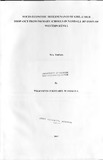| dc.description.abstract | The study sought to unveil factors that contribute to the girl-child drop-out from primary schools in Nambale Division and how the situation can possibly be averted. The specific objectives of the study were to identify personal characteristics of the girl-child that were related to drop-out, parents' characteristics and their relationship to girl-child drop-out and school characteristics that led to drop-out of the girl-child. The study was based on three hypotheses mainly in the relationship between drop-out of the girl-child from primary schools and various determinants such as personal characteristics of the girl-child, parents' characteristics and the school environment.
The study utilised proportionate stratified random sampling technique to select the sample. A sample of 110 school-going pupils was taken from 30 schools in the 5 locations of Nambale Division. The same number of drop-outs was taken from the catchment area surrounding the sampled schools in the 5 locations.
Analysis of data was done using SPSS software and specifically the use of frequency tables where percentages of the respective variables were established. Cross-tabulation was done to compute Chi-square values that revealed how the various variables of study were rated. These Chi-square values were used to test the hypothesized association that existed between the independent and dependent variables of the three hypotheses .
..
The analysis of independent variables under personal characteristics revealed a strong
relationship with dependent variable except the gender of the best friends. All factors under parents' characteristics showed a significant relationship between the independent variables and the dependent variable. The third hypothesis on the characteristics of the school environment had all the independent variables in support of it except one. This was the variable on the size of the class a pupil attended.
The research concluded by encouraging policy makers to concentrate the available resources the empowerment of the girl-child through education. In view of the study findings, a number ul' recommendations have been made. The major recommendation is that drop-out girls
he given opportunity to go back to school if they arc willing to do so. It is also recommended
that further research be carried out to determine the relationship between IIIV/AIJ)S and the girl-child drop-out in Nambale Division. | en |

